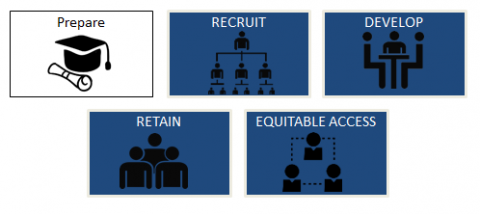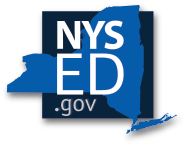New York City Department of Education
STLE Cohort
Total STLE Award
District Links
STLE Program Summary Local Education Agencies(LEAs) and local unions collaborated to develop programs that focus on various elements of a strategically planned Teacher and Leader Effectiveness (TLE) Continuum, including preparation, recruitment and placement, induction and mentoring, evaluation, ongoing professional development/professional growth, performance management and career ladder pathways.
This graphic represents the Teacher and Leader Effectiveness (TLE) continuum recommended by the New York State Education Department.
Program Summary
The New York City Department of Education (NYCDOE) selected 16 high-need high school campuses to participate in the STLE-funded career ladder opportunities for the 2014-2015 school year. Localized in the Bronx, the STLE-funded schools all have above-average rates of English language learners (ELLs) within the school. Through this focus on ELLs, the NYCDOE has increased services and supports to some of their most vulnerable students. In addition, their work with teacher leaders is based on looking at student work in teams in order to identify problems of practice and continue to grow.
[ Read more... ]
In the spirit of collaboration and unity, the NYCDOE successfully worked with the UFT to build the STLE teacher candidate pool in the 16 STLE schools in the Bronx. Principals made final selections and these teachers underwent extensive training to prepare them to serve as Master and Model Teachers to support and mentor other teachers in their schools. For the principal career ladder, the district utilized the expertise of five principals (New Principal Intensive Facilitators; formerly Advanced Principal Mentors) to develop materials for and facilitate the New Principal Intensive (NPI) from July 21 to August 1, 2014. NPI helped prepare new principals to become leaders of their schools, and offered facilitators the opportunity to share expertise and best practices, as well as gain additional leadership experience by facilitating these sessions.
The NYCDOE has also utilized STLE funds to invest in three additional core areas where additional support is most critical to complete effective implementation of their career ladder pathways and Teacher and Leader Effectiveness (TLE) continuum: 1) increasing support for the new principal evaluation and development system; 2) increasing support for the new teacher evaluation and development system; and 3) partnering with the Executive Leadership Institute (ELI) to build the capacity of APs and principals through seminars, mentoring, and collaboration opportunities.
[ Read less... ]
Promising Practice
- Collaborated with the United Federation of Teachers (UFT) and STLE school principals to staff the teacher career ladder. As an institutional priority, educator effectiveness has taken front and center in the district’s collectively bargained contracts with both the teachers’ and school administrators’ unions. As a result, the NYCDOE has been deliberate in cultivating a supportive environment for adult learning through multiple career ladder programs. Through the combination of programs like the federal Teacher Incentive Fund (TIF) grant and STLE, the district has been able to spread the impact of educator development throughout. Under the shared goal of providing advancement opportunities for teachers, the district co-interviewed teachers to ensure that its principals had the best candidates to select from for the STLE-teacher roles.
- Created professional learning opportunities aligned to the teacher and principal development and evaluation systems for educators citywide.
Sustainability
The New York City Department of Education is preparing the district financially to be able to sustain programs and personnel related to career ladder pathways through the general budget and searching for additional grant funds. Currently, both the United Federation of Teacher (UFT) contract and the Council of School Supervisors and Administrators (CSA) contract include career ladder pathway roles and responsibilities.
STLE Areas of Focus and Impact Each Local Educational Agency (LEA) has identified measurable goals and outcomes aligned with their grant programs. Quantitative and qualitative data is meant to communicate the value and impact of this work by highlighting the reach of teacher and principal leaders, cost and time savings, as well as indicate the progress made towards the specific student achievement and talent management needs identified by each LEA. Program evaluation is ongoing; LEAs will continue to monitor impact through and beyond the grant period to better understand correlations between various district and building initiatives, the work of teacher and principal leaders, and the impact on student access and achievement.

This graphic represents the five common talent management challenges. LEAs may address one or more of the five common talent management challenges of preparing, recruiting, developing, retaining and providing equitable access to the most effective educators using career ladder pathways.
Reach
- 24 Model Teachers directly impact 662 teachers which impact 7,467 students
- 5 Master Teachers directly impact 200 teachers which impact 2,309 students
- 11 Professional Principals directly impact 21 principals which impact 588 teachers which impact 8,315 students
Areas of Focus
The New York City DOE’s set out to address the common talent management challenges of recruiting, developing, retaining, and providing equitable access to the most effective educators through their career ladder pathway model.
Common Talent Management Challenges
| Common Talent Management Challenge | Local Educational Agency (LEA) Efforts |
|---|---|
| Recruitment |
As the NYCDOE gather indicators of success from the implementation and use of career ladder pathways, it will be able to use these in the upcoming recruitment cycle. The NYCDOE anticipates that these career ladder roles will impact the talent within schools, encouraging experienced teachers to take on additional leadership and remain in the classroom. |
| Development |
Master and Model Teachers work in teams as teacher leaders and with other colleagues in their schools by opening up their classrooms to provide tangible examples for strong instruction and by facilitating professional learning opportunities. Centrally-based Teacher Team Leaders have provided feedback to create a supportive environment of professional development. Job-embedded professional development site visits are conducted by Talent Coaches (whose training is partially funded through STLE) and provide principals with an opportunity to further their calibration and evaluation of Measures of Teacher Practice. |
| Retention |
As NYCDOE begins to measure the impact of the work and use of grant funds to capture the positive outcomes and lessons learned it is developing a set of materials that can be used as retention tools for current teachers. The district anticipates that these career ladder roles will impact the talent within schools by encouraging experienced teachers to take on additional leadership within their current school rather than leave to take an administrative role at another location. |
| Equitable Access |
The NYCDOE is in the process of securing funding to continue to fund teacher leadership in these 16 schools. It is hoped that this one-year experience as a part of STLE will impact STLE teachers’ professional goals and encourage them to stay in their schools and/or the profession for many years to come. Additionally, as a department the district is hoping to use the lessons learned regarding teacher leadership this school year to determine best practices for implementing teacher career ladders in high-need schools in subsequent years. Having career ladder opportunities will help high-need schools recruit and retain strong teachers, thus helping NYCDOE create a more equitable distribution of teacher leaders in the district. |
Other Areas of Focus
| Other Areas of Focus | Local Educational Agency (LEA) Efforts |
|---|---|
| Annual Professional Performance Review (APPR) |
As part of professional learning and growth programs, both the Teacher Team Leaders (TTLs) and Teacher Development Coaches (TDCs) leverage APPR results to create differentiated learning opportunities for teacher and leader effectiveness throughout the year. Throughout the year, TTLs and TDCs work with teachers—both on and off the career ladder—to provide targeted feedback around the intended focus and assist teachers in implementing new strategies for using their evaluation data for developmental purposes school-wide. Although human capital is an important tool in the journey towards effective educator practices, NYCDOE was also deliberate in developing online resources for teachers and principals around furthering the implementation of the Danielson Framework for Teaching and the APPR evaluation system, Advance. So far, the number of unique visitors accessing these online resources in the 2014-2015 school year has surpassed the amount of visitors at this point during the 2013-2014 school year. Similarly, the NYCDOE is on track to nearly double the number of online learning opportunities they offer by the end of 2014-2015 (from 38 in 2013-2014 to 50 as of December 31, 2014; 71 expected by the end of 2014-15). |
| Evidence-Based Instruction |
Teacher Coaches work side by side with teachers to review student data and student work in order to improve instructional practice. In addition, Teacher Coaches provide actionable feedback on non-evaluative observations. |
Areas of Impact
The New York City DOE has identified quantitative and qualitative impact data that it has seen and hopes to realize since implementing career ladder pathways and related STLE grant activities.
Areas of Impact
| Initial Student Impact |
|
| Early Impact on Talent Management System |
|
Career Ladder Pathways Each LEA participating in STLE 2 or 3 was required to develop and implement or enhance career ladder pathways rooted in sound implementation of their evaluation systems. Career ladder pathways were based on a minimum of three “rungs” including: novice, professional, and leader levels that were associated with specific roles, responsibilities, and optional district-defined compensation incentives.
Career ladder pathways are a systematic, coordinated approach to provide new and sustained leadership opportunities with additional compensation, recognition, and/or job embedded professional development for teachers and principals in order to advance excellent teaching and learning.
Teacher Career Ladder Pathway
| Teacher Title | Roles and Reponsibilities | Compensation | Number Serving in Role in 2014-15 |
|---|---|---|---|
| Novice Teacher |
Design Team Teacher
|
Compensation per session according to Collective Bargaining Agreement |
0 |
| Professional Teacher |
Model Teacher
|
$7,500 Annual Stipend |
24 |
| Teacher Leader |
Teacher Development Coach
Master Teacher
|
Teacher Development Coach: $20,000 annual stipend; Master Teacher: $18,000 annual stipend |
Teacher Development Coach: 1; Master Teacher: 5 |
Principal Career Ladder Pathway
| Principal Title | Roles and Reponsibilities | Compensation | Number Serving in Role in 2014-15 |
|---|---|---|---|
| Novice Principal |
Lab Site Principal
|
Compensation per session according to Collective Bargaining Agreement | 0 |
| Professional Principal |
New Principal Intensive Facilitator
Critical Friends Group (CFG) Facilitator
|
NPI Facilitator: $3,250 stipend; CFG Facilitator: $1,000 stipend | NPI Facilitator: 5; CFG Facilitator: 11 |
| Principal Leader |
STLE Executive Principal
|
$30,000 annual stipend | 0 |
Sharing the Work The Strengthening Teacher and Leader Effectiveness (STLE) grant has resulted in the development and sharing of a wide variety of tools, tips, and resources. Local Education Agencies (LEAs) have been highlighted for their work through various media outlets and NYSED videos, and have also created tools and resources that are available to the field.
Resources
|
|
|
|
|
|
The Office of Teacher/Principal Quality & Professional Development invites you to submit tools and resources to STLE@nysed.gov that will further help the field, including but not limited to: gap analysis templates, career ladder pathway design principles, communication plans, description of sample roles and responsibilities, tools that help gauge the return on investment and strategies for program evaluation. |
Local Media
|
|
|
|
|
We encourage you to continue to contribute to the on-going conversation on Twitter by sharing your work using #STLE. |





